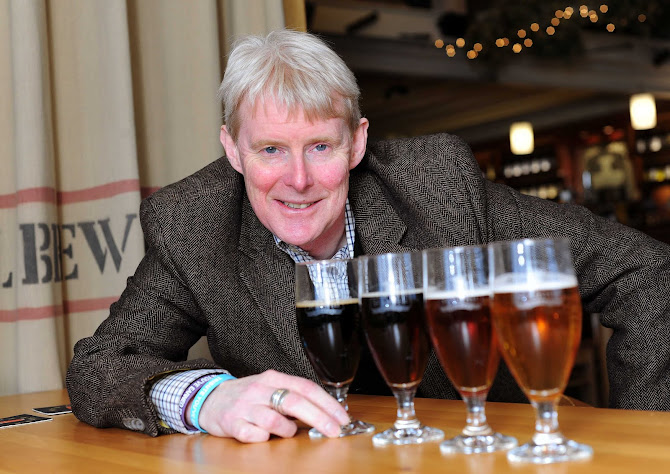The early spring is a fine time to observe garden birds and their feeding habits around the bird table and feeders. Different bird species have individual characters just like beers, so for fun I've listed an analogy of birds and the more popular ales. Hopefully I won't offend anyone, either bird fanciers or beer enthusiasts with my comments, it's just for fun!
 Black Cap & Brewdog Punk IPA
Black Cap & Brewdog Punk IPA
The Black Cap is a recent interloper on many garden bird feeders and something of the bird table bully. He does not care about other birds, he is unconventional, does it his way and takes what he wants when he wants. However as a new visitor he is a welcome addition to any bird table despite his selfish habits.
As a beer analogy, that just has to be Brewdog. A recent arrival in the beer market and totally unconventional, they do the opposite to what other brewers do and are happy to step on a few traditional toes! None-the-less the beer is still pretty good and a welcome option on many bars and supermarket shelves.
House Sparrow & Doombar

An unremarkable grey/brown bird and ten-a-penny on many bird tables. They are always there, normally arriving in small flocks, they ascend the table for a short while then disappear. Perhaps the most frequent of all birds on the table, its easy to take them for granted but without them the table would be a lot less busy and by their very brown nature, they allow the brighter marked birds to strand out from the crowd. So in many ways, they provide the essential background for the other birds to shine. If we have no sparrows, we'd surely miss them.
The beer equivalent would be Doombar. An unremarkable but inoffensive brown beer its everywhere. but, just like the sparrow, without Doom to set the playing field, how would we know the other beers are so good? Some might be pleased if we had no Doombar, but there have always been big volume if somewhat bland beers that dominate the market i.e. Courage Best etc. They are essential as often drinkability is what required most and that means a beer that's easily available with a non descript but accessible flavour.
 Bullfinch & Proper Job
Bullfinch & Proper Job
The Bullfinch is a shy but common bird. When you see him its always a thrill. Superbly marked, Mr Bullfinch is unmistakable and certainly stands out from the crowd. Mrs B is not that bad looking either and its common to see pairs rather than single birds. However they are a reserved couple, never the first to the party and often heard rather than seen. If you get Bullfinches cherish them and encourage them to stay, they are one of the stars of the bird table.
Proper Job is the Bullfinch of the beer world. On draught it's common but not often seen. A frequent visitor as part of many a guest ale programme, its still not easy to find. However once you have it, then it's unmistakable rich citrus hop and bitter backbone, combined with the sharp golden straw colour make it a welcome guest and a beer to encourage the licensee to keep.
Chaffinch & Old Speckled Hen
The Chaffinch is a handsome looking bird. When first seen the male in particular is a good looking fella, but then you come across other more striking birds, the fore-mentioned Bullfinch, the Goldfinch or the Great Tit, all birds that arguably challenge the place of the Chaffinch in terms of looks. However, the Chaffinch is a staple and frequent visitor to garden bird tables, its just they are not quite the stars.
A beer analogy would be Old Speckled Hen. Once the beer of choice of many, its a good beer but not quite a great beer and has been surpassed by many new more interesting arrivals to the bar. The Old Speckled Un as it was originally known, was the forerunner of guest beers from the late 1980's and set the playing field for later arrivals. Its easily dismissed now by beer enthusiasts and those who don't appreciate the commitment to the beer market of the brand owners Greene King. A bit like the Chaffinch, a little under appreciated.
Magpie & Hobgoblin
The Magpie is a big noisy bird, strikingly marked, its also a very loyal bird as couples bond for life. Their reputation for thieving and bullying smaller birds is probably warranted. When it visits the bird table everything else disappears, including our cats! They muscle in, will empty a meal worm feeder in less than an hour then pose as if to say, come on, I'm not frightened of anything. You cant help admiring the Magpie, for all its cheek and bravado.
The beer analogy would be Hobgoblin. Just like the Magpie, it has a band of loyal enthusiasts and it shouts from the shelves with its quirky label design. Its a big bold beer as well, not subtle, its full flavoured, raisins and toffee the marked flavours. Hobgoblin always stands proud on the shelves and bars, nothing to hide, as if to say, that's who I am, if you don't like me I don't really care, I'm here stay. There are better beers out there with far more complexity of flavour, but none-the-less, Hobgoblin will be a regular part of many a BBQ or party over the summer months.
I hope you enjoyed my ramblings here, its just for fun and not mean't to upset anyone. Other suggested garden bird and analogy beer combinations would be as follows.
Raven & Guinness
Goldfinch & Thornbridge Jaipur
Blue Tit & Fursty Ferret
Blackbird & Fullers London Porter
Robin & Adnams Ghostship
















